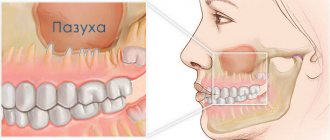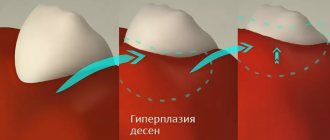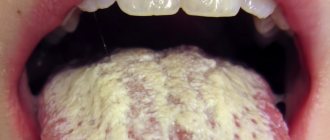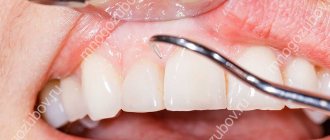Author of the article:
Soldatova Lyudmila Nikolaevna
Candidate of Medical Sciences, Professor of the Department of Clinical Dentistry of the St. Petersburg Medical and Social Institute, Chief Physician of the Alfa-Dent Dental Clinic, St. Petersburg
Candidiasis or, otherwise, thrush is an infectious disease, the main cause of which is infection with Candida fungi. These fungi belong to the same species as yeast and are part of the natural microflora of the vast majority of healthy people. The maximum concentration of these opportunistic microorganisms is observed in the intestines, nasopharynx, and vagina; Some fungi can also be found on the surface of the skin.
In a normal, healthy state of the body, the fungus does not cause any unpleasant symptoms. However, when the immune system is weakened and other provoking factors appear, Candida actively multiplies, resulting in discomfort, itching, burning and other manifestations of thrush. This disease can affect various tissues and organs; Candidiasis of the oral mucosa is also common.
Most often, infants suffer from this disease: according to statistics, up to 20 percent of children under the age of one year have suffered from candidiasis at least once. About 10 percent of people over 60 also suffer from symptoms of this infection. It occurs more often in women than in men; very often, signs of the disease appear in smokers. There are many other factors that contribute to the development of candidiasis in the mouth.
Causes of oral candidiasis
The main reason for the occurrence is a decrease in immune status, as a result of which the uncontrolled proliferation of microflora begins. Reduced immunity is observed in older people and infants, in patients suffering from HIV, AIDS and other diseases associated with immunodeficiency, in those who regularly expose the body to excessive stress, neglect the rules of a healthy diet and violate work and rest patterns. Risk factors include reasons such as:
- Use of medications.
Taking antibiotics, immunosuppressants (drugs that suppress the immune system) and some other medications leads to disruption of the immune system and the natural balance of microflora in the body. Oral contraceptives, which affect hormonal levels, have a similar effect. - Pregnancy.
During pregnancy, a sharp and significant change in hormonal levels occurs, which can lead to a surge in the activity of pathogenic and opportunistic microflora. - Radiation and chemotherapy.
Often occurs in patients undergoing drug and radiological treatment for cancer. - Injuries to mucous membranes.
Violation of the integrity of the mucous membranes leads to loss or deterioration of the barrier function, as a result of which the fungus enters deep into the tissues, causing inflammation and other symptoms. Small, but constantly recurring injuries are especially dangerous - for example, when wearing incorrectly fitted dentures or braces. - Overwork and stress.
Prolonged stress of physical and mental forces leads to a deterioration in the protective function of the body. Similar consequences are caused by hypothermia or overheating, regular lack of sleep, insufficient, excessive or simply unbalanced nutrition, abuse of alcohol, nicotine, and narcotic substances. - Hypo- and vitamin deficiency.
May be caused by a lack of nutrients, in particular vitamins B and C. - Somatic diseases.
Frequent companions of candidiasis include tuberculosis, dysbacteriosis and other pathologies of the gastrointestinal tract, diseases of the adrenal glands and other endocrine glands. Candidiasis is a contagious disease. A large number of pathogenic microorganisms are transmitted through kissing and sexual contact, through the use of shared dishes, towels and other household items. Infection can also occur during childbirth (vertical transmission from mother to fetus). In addition, there is a risk of infection through contact with infected pets.
Features of diet No. 3 for constipation
The weekly dietary menu is designed taking into account the balance of proteins and carbohydrates in the diet. At the same time, there is an increase in the amount of fat due to the inclusion of vegetable oils. The diet involves consuming 100–120 g of fat, 85–100 g of protein, 450–500 g of carbohydrates.
Table No. 3 does not provide for the obligatory chopping or grinding of food. It is allowed to consume boiled and baked dishes, as well as carbonated mineral water in moderate quantities. You can cook porridge with milk diluted with water in a 1:1 ratio.
Drinks and foods whose temperature is below 15 °C increase peristalsis and reduce the production of gastric juice. Therefore, for constipation, it is recommended to drink chilled drinks. Before breakfast, it is advisable to drink a glass of cold water, and at night - compote or kefir. In addition, to soften the stool, it is useful to take 1-2 tablespoons of unrefined vegetable oil on an empty stomach. The oil coats the intestines and improves the movement of feces.
You can follow the diet for a long time. With this diet, the frequency and consistency of stools are normalized. This diet is indicated for constipation caused by an unbalanced diet and a sedentary lifestyle.
Prohibited Products
Like other diets, “Table No. 3” involves excluding certain foods from the diet. These include:
- flour products from yeast and puff pastry;
- fatty fish and meat, strong meat broths;
- radish, horseradish, garlic and other spicy vegetables;
- spicy sauces, mustard, hot pepper;
- strong tea, coffee and other caffeinated drinks;
- canned foods, fried eggs;
- legumes, mushrooms (mushroom broths are allowed);
- bananas, dogwood, blueberries, nuts;
- drinks with tannins: jelly, cocoa, drinks made from quince, bird cherry and blueberry.
Whole milk, smoked meats, fried and pickled foods are not recommended. You also need to exclude alcoholic drinks, chocolate, pasta, and legumes. Prohibited foods include rice, semolina, sweets with cream, and margarine. There is no need to eat foods that are difficult to digest: mashed potatoes, canned food, hard-boiled eggs, slimy soups.
Types of disease
The clinical picture of oral candidiasis is classified:
- For clinical and morphological.
- With the flow.
- By localization.
Clinical and morphological is divided into:
- Hyperplastic.
- Erosive-ulcerative.
- Pseudomembranous.
- Atrophic.
The clinical picture, classified according to the course, is divided into:
- Chronic.
- Spicy.
By localization:
- Cheilitis.
- Gingivitis.
- Glossitis.
- Stomatitis.
- Tonsillitis, etc.
Based on the clinical picture, oral candidiasis comes in several types:
- Chronic hyperplastic.
- Candida infection.
- Chronic atrophic.
- Acute pseudomembranous.
- Chronic pseudomembranous.
- Acute atrophic.
Menu (Power Mode)
Based on the principles of proper nutrition for candidiasis , you can create a varied menu. You need to alternate protein dishes daily, supplementing them with vegetable side dishes.
Breakfast usually consists of porridge cooked in water, vegetable salad or stewed vegetables, cottage cheese or omelet, and a decoction of herbs. Try to prepare vegetable soups, borscht and cabbage soup, including permitted vegetables in the first courses.
For main courses, choose boiled chicken, meat cabbage rolls, baked meat or fish, meat and fish meatballs and cutlets. As a side dish you should use stewed or fresh vegetables and occasionally porridge. Limiting salt and sugar certainly affects the taste of food. For dinner you can make cheesecakes and cottage cheese casserole. All snacks should consist of yogurt or biokefir; you should also drink rosehip infusion, unsweetened compotes, fruit drinks, and herbal teas during the course.
Symptoms
Infection of the oral mucosa by Candida fungus can take various forms, each of which has its own characteristics of symptoms. The most common forms of the disease are candidal angulitis, glossitis, cheilitis, and stomatitis. There are both acute and chronic forms of the disease.
- Pseudomembranous acute candidiasis is the most common form and most often occurs in infants and the elderly. This form is characterized by the appearance of severe swelling and hyperemia (redness) of the mucous membranes. In addition, a characteristic whitish coating forms on the surface of the lips, palate, back of the tongue and the inside of the cheeks. If the plaque is scraped off, the surface of the mucous membrane underneath will be macerated (softened) or ulcerated and bleeding. In this case, patients complain of pain, burning or itching in the mouth; Eating becomes very difficult. Very often the process spreads to the esophagus and pharynx.
- Acute atrophic candidiasis of the oral mucosa usually develops due to the lack of adequate treatment. The upper part of the mucous membranes (epithelium) is exfoliated, the mucous membrane becomes thin, red or, on the contrary, swollen. The patient’s tongue and the corners of the lips also acquire a bright red color; the papillae on the tongue atrophy and smooth out. The plaque is absent or is found only in hard-to-reach places.
- Hyperplastic chronic candidiasis is characterized by the formation of a large number of papules and plaques of irregular or round shape. They are located close to each other on the mucous membrane of the tongue and cheeks and often become soldered and fused. Around each such formation there is a thin rim of reddened, inflamed tissue. It is difficult to scrape off or otherwise remove such a plaque. The oral cavity becomes dry and rough; When chewing, speaking, and even at rest, patients experience significant discomfort and pain. It should be noted that this disease most often affects men over 30 years of age.
The main cause of the chronic atrophic type is constant injury to the mucous membranes, for example due to wearing a prosthesis. Symptoms of the disease are localized in the affected area. Redness of the mucous membrane occurs (often along the contour of the lesion), plaque forms, pain and burning occur, and the membranes become dry.
Fully or partially limited products
- Products containing additives and preservatives that can disrupt the balance of microflora.
- Eliminate all types of simple carbohydrates and products containing fructose, galactose, sorbitol, glucose, maltose. Fruit juices and sweet fruits should not be consumed.
- Use caution with nuts and dried fruits, which may contain invisible mold, and dried fruits may be high in fructose.
- Products containing yeast (kvass, baked goods and beer) are excluded. It is better not to eat grapefruits, lemons, pineapples, oranges, or tomatoes for a month, as they create an alkaline environment favorable for the growth of fungi.
- You should not consume all products that have an irritating effect: mayonnaise, ketchup, hot seasonings, horseradish, vinegar, mustard, salty and pickled foods, canned food and smoked meats. Mushrooms and blue cheeses are prohibited.
- Avoid fatty pork, duck and goose meat, fatty and smoked fish, and canned fish. Remember that fried foods promote the growth of yeast.
- From drinks you should exclude strong coffee and tea, beer, sweet juices, kvass, sweet water with carbonation and alcohol - all of them are provocateurs of candidiasis infection.
Table of prohibited products
| Proteins, g | Fats, g | Carbohydrates, g | Calories, kcal | |
Vegetables and greens | ||||
| canned vegetables | 1,5 | 0,2 | 5,5 | 30 |
| zucchini | 0,6 | 0,3 | 4,6 | 24 |
| potato | 2,0 | 0,4 | 18,1 | 80 |
| corn | 3,5 | 2,8 | 15,6 | 101 |
| carrot | 1,3 | 0,1 | 6,9 | 32 |
| canned cucumbers | 2,8 | 0,0 | 1,3 | 16 |
| squash | 0,6 | 0,1 | 4,3 | 19 |
| radish | 1,2 | 0,1 | 3,4 | 19 |
| white radish | 1,4 | 0,0 | 4,1 | 21 |
| turnip | 1,5 | 0,1 | 6,2 | 30 |
| beet | 1,5 | 0,1 | 8,8 | 40 |
| canned tomatoes | 1,1 | 0,1 | 3,5 | 20 |
| Jerusalem artichoke | 2,1 | 0,1 | 12,8 | 61 |
| pumpkin | 1,3 | 0,3 | 7,7 | 28 |
| horseradish | 3,2 | 0,4 | 10,5 | 56 |
Fruits | ||||
| avocado | 2,0 | 20,0 | 7,4 | 208 |
| pineapples | 0,4 | 0,2 | 10,6 | 49 |
| oranges | 0,9 | 0,2 | 8,1 | 36 |
| watermelon | 0,6 | 0,1 | 5,8 | 25 |
| pears | 0,4 | 0,3 | 10,9 | 42 |
| melon | 0,6 | 0,3 | 7,4 | 33 |
| figs | 0,7 | 0,2 | 13,7 | 49 |
| tangerines | 0,8 | 0,2 | 7,5 | 33 |
Berries | ||||
| grape | 0,6 | 0,2 | 16,8 | 65 |
Mushrooms | ||||
| mushrooms | 3,5 | 2,0 | 2,5 | 30 |
| marinated mushrooms | 2,2 | 0,4 | 0,0 | 20 |
Nuts and dried fruits | ||||
| raisin | 2,9 | 0,6 | 66,0 | 264 |
| dried apricots | 5,2 | 0,3 | 51,0 | 215 |
| dried apricots | 5,0 | 0,4 | 50,6 | 213 |
| dates | 2,5 | 0,5 | 69,2 | 274 |
Cereals and porridges | ||||
| corn grits | 8,3 | 1,2 | 75,0 | 337 |
| white rice | 6,7 | 0,7 | 78,9 | 344 |
Bakery products | ||||
| bread | 7,5 | 2,1 | 46,4 | 227 |
Confectionery | ||||
| jam | 0,3 | 0,2 | 63,0 | 263 |
| cake | 3,8 | 22,6 | 47,0 | 397 |
Chocolate | ||||
| chocolate | 5,4 | 35,3 | 56,5 | 544 |
Raw materials and seasonings | ||||
| mustard | 5,7 | 6,4 | 22,0 | 162 |
| yeast | 12,7 | 2,7 | 0,0 | 75 |
| ketchup | 1,8 | 1,0 | 22,2 | 93 |
| mayonnaise | 2,4 | 67,0 | 3,9 | 627 |
| honey | 0,8 | 0,0 | 81,5 | 329 |
| sugar | 0,0 | 0,0 | 99,7 | 398 |
| soy sauce | 3,5 | 0,0 | 11,0 | 58 |
| vinegar | 0,0 | 0,0 | 5,0 | 20 |
Dairy | ||||
| milk | 3,2 | 3,6 | 4,8 | 64 |
Meat products | ||||
| pork | 16,0 | 21,6 | 0,0 | 259 |
Bird | ||||
| smoked chicken | 27,5 | 8,2 | 0,0 | 184 |
| duck | 16,5 | 61,2 | 0,0 | 346 |
| smoked duck | 19,0 | 28,4 | 0,0 | 337 |
| goose | 16,1 | 33,3 | 0,0 | 364 |
Fish and seafood | ||||
| smoked fish | 26,8 | 9,9 | 0,0 | 196 |
Alcoholic drinks | ||||
| beer | 0,3 | 0,0 | 4,6 | 42 |
Non-alcoholic drinks | ||||
| cola | 0,0 | 0,0 | 10,4 | 42 |
| coffee | 0,2 | 0,0 | 0,3 | 2 |
| lemonade | 0,0 | 0,0 | 6,4 | 26 |
| Pepsi | 0,0 | 0,0 | 8,7 | 38 |
| sprite | 0,1 | 0,0 | 7,0 | 29 |
| black tea | 20,0 | 5,1 | 6,9 | 152 |
Juices and compotes | ||||
| apricot juice | 0,9 | 0,1 | 9,0 | 38 |
| Orange juice | 0,9 | 0,2 | 8,1 | 36 |
| * data is per 100 g of product | ||||
How does the disease manifest in children?
In children, the disease occurs in an acute form and is accompanied by the appearance of redness and swelling in the oral mucosa. The child sleeps poorly, may have no appetite, and becomes tearful.
The disease can occur in children for the following reasons:
- Weakening of the immune system.
- Infection during breastfeeding.
- Transmission of the fungus during childbirth.
- Infection through household items.
If the disease is not diagnosed and treated in a timely manner, a whitish coating resembling cottage cheese will soon appear in the child’s mouth, and in an advanced stage, ulcers will appear, which are accompanied by bleeding and cause severe pain in children.
Diagnostics
To make an accurate diagnosis, a combination of several methods is used - from a simple examination and questioning of the patient for complaints to laboratory methods, such as culture, microscopic examination of biomaterial, analysis of the degree of contamination of the oral cavity with fungal mycelium.
Oral candidiasis is accompanied by a number of characteristic external signs, in particular the formation of plaque, bad breath, ulceration and hyperemia of the mucous membranes. However, laboratory methods make it possible to accurately determine the type of pathogen and exclude the possibility of a secondary infection, which may affect the nature and duration of treatment.
Differential diagnosis is used to separate cases of candidiasis from aphthous stomatitis, leukoplakia, lichen ruber, streptococcal infection and other infectious pathologies of the oral cavity.
How to treat oral candidiasis?
Treatment is carried out using local and general, specific and symptomatic remedies. Among the main goals of therapy are the elimination of foci of infection in the oral cavity (sanitation), treatment of diseases that accompany candidiasis and are risk factors, and stimulation of the body's defenses. The total duration of treatment is usually at least 7-10 days.
As a means of local therapy, rinses are used - using solutions of boric acid, soda, sodium tetraborate. For a longer and more effective effect, such products can be used in the form of applications - moistening a cotton swab or bandage with the solution.
Nystatin for oral candidiasis is used to combat the main cause of the disease - a fungal infection. Treatment of candidiasis in the mouth may also include the use of other antimycotic (antifungal) drugs - for example, levorin ointment. The best effect is achieved by using several drugs, alternating them for several days.
Antifungal drugs are also prescribed for systemic therapy - in this case, medications for oral candidiasis and other infections such as Lamisil, Diflucan, Levarin, Nizoral, etc. are taken orally. In the most severe cases of the disease, the treatment regimen includes taking immunomodulatory drugs, as well as the use other agents that have a stimulating effect on the immune system and help strengthen the body’s own defenses.
An equally important task is to protect against additional fungal and bacterial infections that can join the Candida infection and complicate the course of the disease. For this purpose, rinses with antiseptic solutions - fucorcin, iodinol and others.
As an alternative, you can use ASEPTA antiseptic mouth rinse, which contains the active ingredients chlorhexidine and benzydamine. Both of these substances have broad antimicrobial effects. Regular use of ASEPTA rinses also has a pronounced anti-inflammatory effect and helps not only eliminate unpleasant symptoms, but also reduce the risk of complications.
Authorized Products
Diet No. 3 for constipation is aimed at increasing the proportion of foods that enhance colon motility, namely:
- containing organic acids in large quantities: sauerkraut, citrus fruits, fruit drinks from sour berries and fruits, fermented milk drinks;
- with a high content of plant fiber: dried fruits, bran, cereals, wholemeal bread, raw vegetables (spinach, cabbage, radishes, carrots, etc.);
- cold first courses and desserts: okroshka, beetroot soup, ice cream;
- stringy lean meat: veal, rabbit, turkey, beef;
- lean fish: hake, cod, as well as any seafood;
- compotes, weak tea, chicory, rosehip decoction, natural juices.
The diet includes the inclusion in the diet of products with a laxative effect, as well as those that stimulate intestinal motility, such as honey, grapes, sweet apples, peaches, pumpkin, dates. Softening stool is facilitated by eating foods that swell in the digestive tract and facilitate the process of bowel movement.
Dietary fiber contained in cereals, vegetables and fruits is not digested. They absorb toxins and other harmful substances and activate peristalsis. Organic acids inhibit the growth of pathogenic microflora, increase the contractility of the intestinal muscles and normalize stool.
Diet No. 3 involves eating beets, cucumbers, tomatoes, zucchini, cauliflower, and broccoli. For constipation, it is allowed to add green peas and white cabbage to the diet. It is advisable to include fresh cottage cheese, sour cream, as well as fermented milk drinks in the five-day or seven-day menu: yogurt, kumiss, fermented baked milk or drinking yogurt.
If you have problems with bowel movements, you need to eat more berries and fruits containing plant fiber and sugar. For example, nectarines, apricots, plums, melons, watermelons. It is allowed to eat mild cheeses, scrambled eggs, and cream. For sweets, it is better to choose marshmallows, marmalade, jelly, and marshmallows.
You can and should add parsley, dill, cilantro and other greens to your food. Food must be cooked in vegetable or butter. Table No. 3 is quite diverse.
Disease prevention
Preventive measures are aimed at improving the condition of the microflora. These include:
- Proper oral hygiene.
- A thoughtful diet with a high amount of protein foods and reduced consumption of foods containing glucose.
- Quitting smoking and alcoholic beverages.
- Timely examination by the attending dentist for the prevention, diagnosis and treatment of the disease.
- Avoid taking medications, such as antibiotics, without first consulting your doctor.
- If the patient has dentures, then one of the preventive measures will be their regular treatment in a special solution.
Sources:
- The role of anti-inflammatory rinse in the treatment of periodontal diseases (L.Yu. Orekhova, A.A. Leontyev, S.B. Ulitovsky) L.Yu. OREKHOVA, Doctor of Medical Sciences, Prof., Head of Department; A.A. LEONTIEV, dentist; S.B. ULITOVSKY, Doctor of Medical Sciences, Prof. Department of Therapeutic Dentistry of St. Petersburg State Medical University named after. acad. I. P. Pavlova
- Report on clinical trials to determine/confirm the preventive properties of commercially produced personal oral hygiene products: mouth rinse "ASEPTA PARODONTAL" - Solution for irrigator." Doctor of Medical Sciences Professor, Honored Doctor of the Russian Federation, Head. Department of Preventive Dentistry S.B. Ulitovsky, doctor-researcher A.A. Leontiev First St. Petersburg State Medical University named after academician I.P. Pavlova, Department of Preventive Dentistry.
- Study of the clinical effectiveness of treatment and prophylactic agents of the Asepta line in the treatment of inflammatory periodontal diseases (A.I. Grudyanov, I.Yu. Aleksandrovskaya, V.Yu. Korzunina) A.I. GRUDYANOV, Doctor of Medical Sciences, Prof., Head of Department I.Yu. ALEXANDROVSKAYA, Ph.D. V.Yu. KORZUNINA, asp. Department of Periodontology, Central Research Institute of Dentistry and Maxillofacial Surgery, Rosmedtekhnologii, Moscow
What should be the diet for gastrointestinal diseases?
The diet for intestinal diseases should not be meager; on the contrary, it will be necessary to include sufficiently high-calorie foods in the diet. If a person’s food absorption process is disrupted, then he usually begins to quickly lose weight, not only fat, but also muscle tissue “melts”. This process must be balanced by increasing the amount of complete protein entering the body (at least 130-140 g).
It is recommended to switch to fractional meals
and eat small meals 5-6 times a day to reduce stress on the intestines. Food will enter the body more evenly, and the body will be able to absorb more nutrients.







